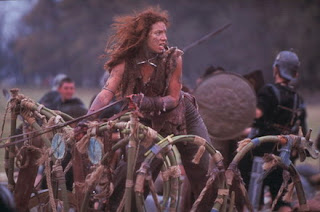Boudica - The Warrior Queen
I've always been fascinated with the legend and history of this Iceni (of British) heroine queen. Hers is a story of indomitable will, determination and courage in the face of danger, hardship and horror.
 |
| Boudica by Mina Olivier* |
Two historical sources remain that give us some insight into the life of Boudica and the rebellion she led - Tacitus and Dio."Dio says that she was "possessed of greater intelligence than
often belongs to women", that she was tall, had hair described as
reddish-brown or tawny hanging below her waist, a harsh voice and a
piercing glare, and habitually wore a large golden necklace (perhaps a torc), a many-coloured tunic, and a thick cloak fastened by a brooch." (source: http://en.wikipedia.org/wiki/Boudica)
Boudica ruled the Iceni tribe, a warrior people, with her husband, Prasutagus. For awhile, the tribe remained independent of Rome and was a nominal ally. When Prasutagus died, he left half of the kingdom to the Roman Empire, and half to his wife and two daughters. However, the Romans had different ideas and took the whole of the Iceni kingdom as a conquered land. When Boudica protested, standing up for her people, she was ordered flogged and her daughters raped right in front of her.
 |
| Boadicea Haranguing the Britons by John Opie* |
Following these events, Boudica was more determined than ever to see her people free and her kingdom independent of Rome. Around AD 60, she led a revolt against Rome and the Roman governor Gaius Seutonius Paulinus.
 |
| Boudica as portrayed by actress Alex Kingston* |
Eventually, Boudica took her forces to Londinium (modern London). The Roman governor evacuated the city, and Boudica burned it to the ground. About 80,000 people were killed during the raids on three major towns. However, Romans were able to regroup and defeat the Britons. It is not clear what happened to Boudica after the Battle of Watling Street, where her defeat took place. She either killed herself to avoid capture or fell mortally ill - sources disagree on this count.
 |
| Statue at Westminster Bridge (1902). It's creation was sponsored by Prince Albert, Queen Victoria's consort. |
Boudica legend lives on and during the Victorian times, Queen Victoria herself was portrayed as the warrior queen. Boudica became one of the most important symbols of Great Britain.
 | ||
| Modern interpretation of Boudica (source: http://quickreaver.deviantart.com/art/Boudica-Modern-93726844)* |
Disclosure: none of the images belong to me and are only used here for illustrative purposes.

What a fantastic story! I can hardly believe that I've never heard of her. Hmmm, sounds to me like someone needs to write a good book about her...
ReplyDelete